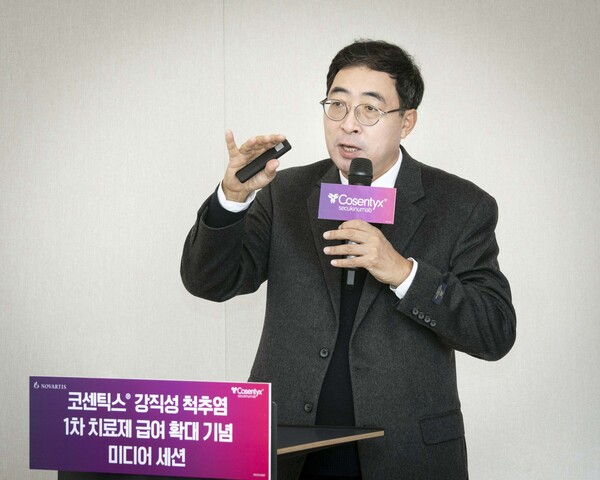The Korean ankylosing spondylitis treatment market is at a significant turning point thanks to the expansion of health insurance benefits for related drugs, an expert said.

Ankylosing spondylitis, if left untreated, can lead to a hunched back and stiff neck. Typically, the disease begins with alternating pain in both hip bones, necessitating immediate medical evaluation to confirm the condition.
According to the Health Insurance Review and Assessment Service (HIRA), the number of patients seeking hospital treatment for ankylosing spondylitis increased by about 22 percent over five years, from 41,797 in 2017 to 51,106 in 2021. The disease is more prevalent in young men, especially in people in their 20s to 40s, with male patients outnumbering females by 2.5 times.
Amid the growth of patients, Professor Sang-Heon Lee from the Department of Rheumatology at Konkuk University Hospital stressed that Cosentyx (ingredient: secukinumab), by Novartis Korea, emergef as a powerful first-line treatment option.
Professor Lee emphasized the importance of treating ankylosing spondylitis, not just as a spinal disorder but as a systemic inflammatory disease that can affect various organs, potentially leading to respiratory issues and fractures. Thirty percent of patients experience uveitis, which can result in blindness.
“Historically, the primary treatment for ankylosing spondylitis involved the use of biological agents, specifically TNF-alpha inhibitors,” Lee said. “However, this approach had limitations, especially considering the unique characteristics and needs of individual patients.”
The medical community has long recognized the necessity for a broader range of treatment options, he added.
Lee stressed that the recent approval and health insurance benefits of IL-17A inhibitors, such as Cosentyx, as a first-line treatment marks a pivotal change.
“These inhibitors cater to the individual characteristics of patients, offering a more personalized approach to treatment,” he said. “The inclusion of IL-17A inhibitors as a primary treatment option not only broadens the therapeutic landscape but also indicates a significant shift towards more customized patient care.”
When asked how Cosentyx compares to other treatments, such as TNF-alpha inhibitors or JAK inhibitors, such as AbbVie’s Rinvoq and Pfizer’s Xeljanz, Lee emphasized the importance of having diverse treatment options that take into account individual patient characteristics.
“IL-17A inhibitors like Cosentyx directly block IL-17A, effectively suppressing the disease from its early stages,” Lee said. “IL-17A inhibitors, including Cosentyx, have proven to have lower risks of causing infections and tuberculosis compared to TNF-alpha inhibitors.”
Also, while JAK has the benefits of being an oral drug, such benefits do not stand out when treating ankylosing spondylitis as most ankylosing spondylitis patients are young and have no problem using an injectable biologic treatment like Consentyx, he added.
Lee stressed that the advancement in treatment options is expected to lead to better outcomes for patients and healthcare providers alike.
“By providing an alternative to traditional TNF-alpha inhibitors, IL-17A inhibitors represent a new era in the treatment of ankylosing spondylitis, offering hope and improved quality of life to those affected by this challenging condition,” he said. “The medical community eagerly anticipates the positive impact this will have on patient care and outcomes.”

